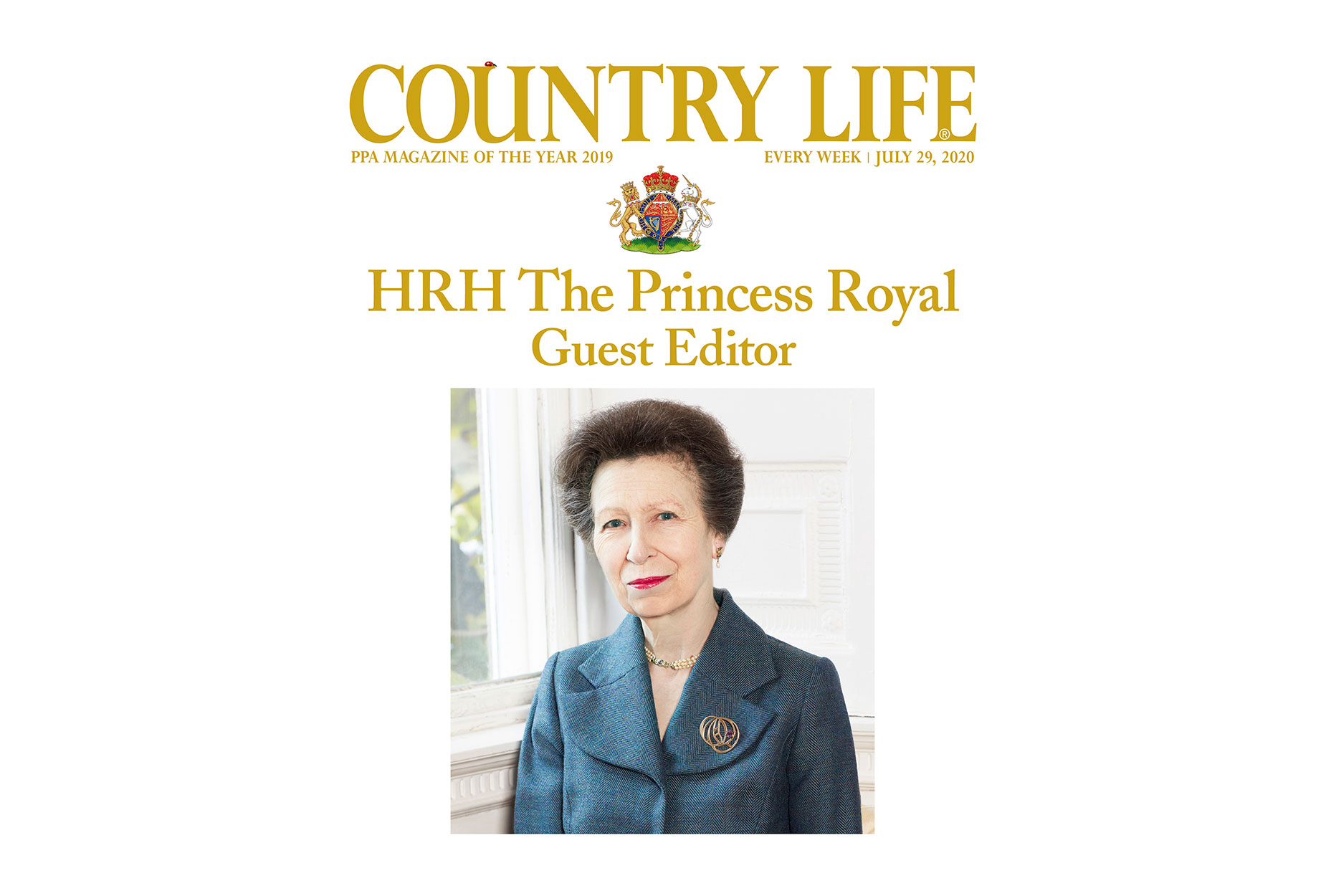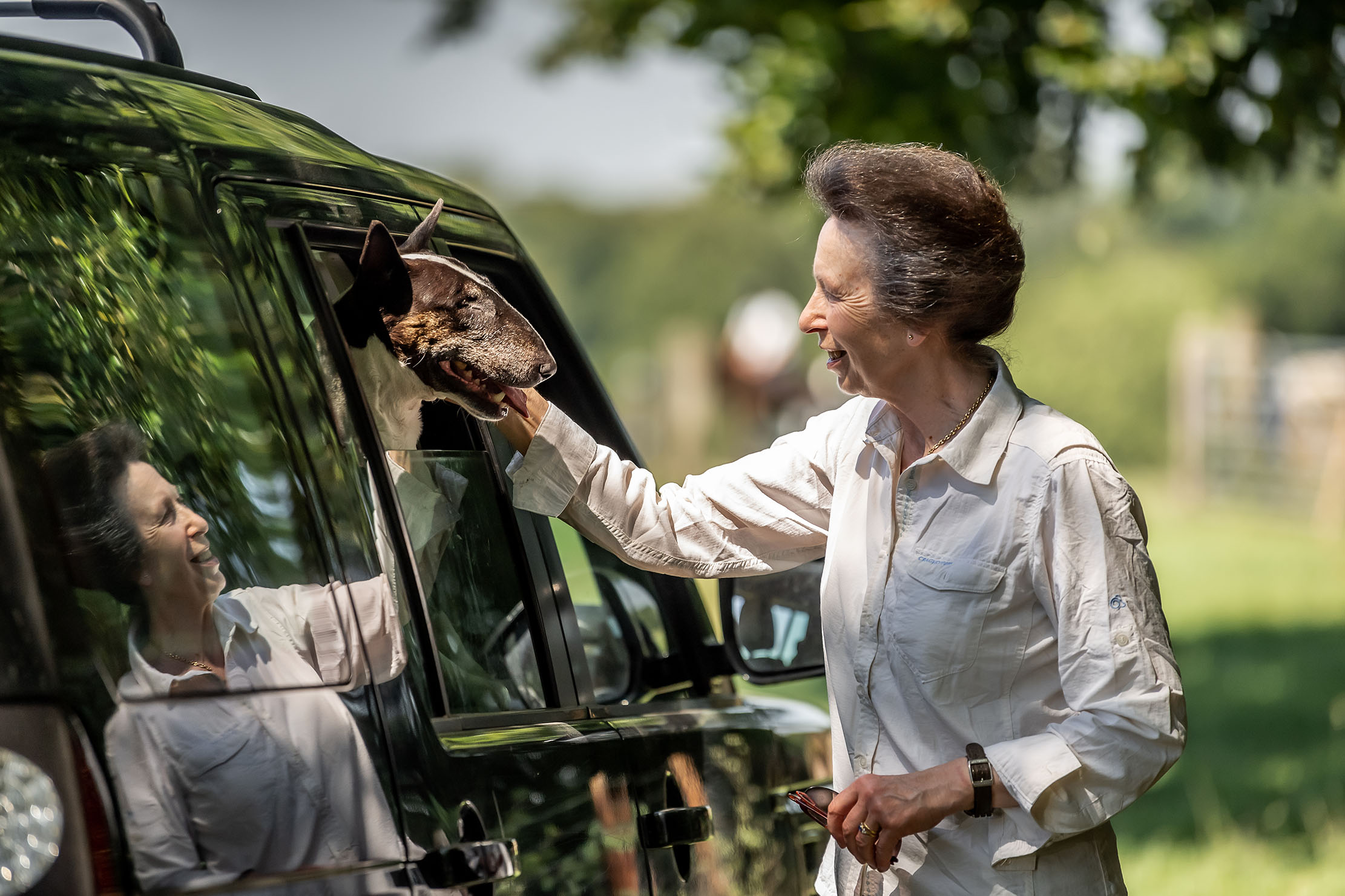Princess Anne on Nature, the countryside, and working towards a brighter future for all of us
The Princess Royal has guest-edited the 29 July issue of Country Life. In her leader article, she pays tribute to her parents for instilling a lifelong love of Nature and urges us all to be more careful about waste and energy in the hope of securing a brighter future for the countryside.


Princess Anne kindly agreed to guest edit the 29 July issue of Country Life. This is her leader article from the magazine, which is on sale now.
Find out more here about what is in the 29 July 2020 issue of Country Life, and if you aren't able to get to a shop to pick up the magazine you can buy a single issue here if you're in the UK or here if you're overseas.
Every year, month and day, I realise how fortunate and privileged I am to have grown up and spent most of my life in the countryside. It’s not only the space, appreciating the seasons, the wildlife, the plant life, the arable crops and the livestock, but, most importantly, it’s the people who live and work there and understand the complexity of their environment.
I was equally fortunate that both my parents had a love and understanding of the natural world through their own experiences. Perhaps even more so for my father when, during his rather disjointed young life, he ended up at school at Gordonstoun and was introduced to the wilds of Scotland, both land and sea.
Scotland had its influence on my mother, too, as did the big skies of Norfolk, and the huge fields and marshes of the Sandringham Estate. Windsor’s Home Park and Great Park were a constant presence for her, as they were for all of us. They had horses, dairies, hens, pigs — you could never be bored as a child. Windsor was and is a haven of peace, although not so quiet since the growth of air travel — until the lockdown.
Superficially, not much has changed since I was young; the Jersey herd is still there, although the cows now enjoy a robotic parlour. There are Sussex cattle in the Great Park and the crops are a different mix, but the forest is still there, as are ponds and wet areas, the Savill Gardens and Frogmore House Gardens. Buildings and skills that the Prince Consort would have recognised.
Prince Albert’s influence is seen so often at the forefront of research and practical application, not least in agriculture and building design. His model farm at Windsor, for instance, and nearly all the buildings at Balmoral improved the use of space and integrated more efficient use and better distribution of water. My father was impressed by Prince Albert’s approach to forward-thinking and sustainable developments and has added his own understanding to encourage others to build on the knowledge of their predecessors. The Royal Commission of 1851 was set up by the Prince Consort after the Great Exhibition to build on its success of creativity, innovation and trade. When my father was its president, he oversaw an extraordinary investment in talent across the whole spectrum of research, including the science and practice of agriculture and sustainable land use. I now have the privilege of being its president, which also reminds me of the wealth of knowledge that I have been exposed to throughout my life and the part my family has played in growing that knowledge.
Exquisite houses, the beauty of Nature, and how to get the most from your life, straight to your inbox.
Prince Philip has added his own unique talents by being very well briefed, then engaging and bringing together all interests that are part of the countryside. He is a very hard act to follow, but I’m grateful for the time he gave us and the example he set us.

It is only later in life that you realise how much you have been exposed to and how much you have absorbed from your early years. We were taught to observe and question, to be open minded, to understand differences, to treat every person as an individual with their own skills and to remember there is very little that is completely new under the sun. We are where we are because our ancestors not only survived by living off the land, water and air, but also innovated ways of doing so more easily and successfully; so successfully that a shortage of food seems a distant threat for much of the western world. However, although we may be growing more, the access to and distribution of good-quality foods is still a challenge.
We are living through a real global pandemic that is affecting literally every person’s life in some way, even if they and their countries have barely suffered directly from Covid-19. The effect on global food supplies through the restrictions on transport and logistics should raise our awareness of the vulnerability of the modern — just in time — demand-and-supply approach and highlight the strengths of local production and markets. Change will require all land users to work even more closely together to understand the most appropriate and least damaging way to increase production of crops and livestock that best suit our ground conditions and weather. It also means finding the right space and access for those who wish to enjoy the non-producing areas.
The restrictions that Covid-19 has placed on the entire population have accentuated the pressure between town and country. However, it has also shown that, thanks to historic houses, caravan parks, national parks, forestry enterprises, riding and cycling trails, rambling routes and assorted types of accommodation, access was quite well catered for already as an important contributor to the rural economy. The pandemic has highlighted the number of people and jobs that are crucial to that economy, too, be it the hospitality sector, conservation projects or the farming sector, such as the harvesting of many crops, fruit and vegetables and the care of livestock, especially sheep-shearing. Those jobs are still hard physical work that also need skills to achieve the standards that the buying public expect.
Technology is already making an impact in these areas and will make a bigger impact as the innovators and practitioners work out what is adding value and efficiency, without doing any more damage to the environment. Education and training play a big part in the shared understanding, success and enjoyment of the countryside. Our knowledge is derived from experience, evaluation and development and we need that information to be readily available. The royal agricultural societies, the county agricultural shows and societies — which are often the gatekeepers to public enquiry and understanding — the further-education colleges and universities that still maintain links with the rural economy and the people who live and work in the countryside are more important than ever, especially as there is no such thing as an unskilled job.

Research has made progress, but single-issue research must never lose sight of the overall subject. I mean that, for instance, one type of crop, with very specific qualities, may not be the best crop for every environment. Nature’s ability to adapt is, on the whole, better than humans or, indeed, computer-model-driven versions. How do we combine the best of both, the single-issue expertise and the need for a holistic view? Hopefully, by recognising that practitioners, residents and consumers can all access accurate information, education and training so that they can contribute to the debate and the research on best practice for the countryside.
How do I define best practice? Understanding how to work better with local conditions and working with Nature, which could be by using very traditional methods. Yet also using technology to support farming and related jobs, as well as extending the employment opportunities to those who would rather stay in the countryside. Not everybody does, which is just as well, as there is already a shortage of affordable houses in most areas.
One of my pleas for best practice is quality, appropriate housing of the right type and the right numbers in the right places. Housing for local families that are priced out of the market; for young, single people who would like to stay and work in their home village or area; young families; and retired people who were born in the village and would like to return home. All of them could make the difference to having a viable school, shop or pub in the village. Importantly, these housing developments should be small and remain in the control of the local parish council, either for rent or shared ownership — preferably small because of two other best-practice issues: waste and energy.
Waste — produced by humanity and the way it chooses to live — that is not dealt with appropriately is up there with not understanding the value of small housing developments built to last as a major irritation to me! If you want to help the planet, controlling our waste is something everyone can do and it will make a difference. We will always produce waste, however efficient we become, so we must get better at reducing it at every stage and dealing with it better at the end. That means making things such as clothes, furniture, vehicles and supermarket trolleys that can be recycled safely and economically and not dumped on someone else’s ground. Did I mention that fly-tipping is another major irritation to me?
There are some perfectly good waste and recycling systems out there already, including anaerobic digesters and waste-to-energy plants. I would hope we can be more innovative and local in the way we deal with our rubbish to encourage everybody that it is worth making the effort to put waste in the right places, recycle more and have the confidence that it will make a difference.
Everything about life today seems to be about convenience and waste is seen as inconvenient; we must help make it more convenient to deal with. Raising the profile of the country code might help, especially as the post-coronavirus getaway to the country seems to have resulted in an increase of littering and vandalism.

Reliable energy supplies are critical to everybody and renewable energy created by innovative and local solutions will be a crucial part of the networks. Rural areas could be even more self-sufficient, especially if much of the equipment is to be electric. Replacing fossil-fuel generators has not been easy, but covering the countryside in solar panels and windmills isn’t really the answer, either. Using water better, using waste from crops, using waste from woodlands and the ability to store energy, possibly as hydrogen, can all help, but will require a more flexible grid and, therefore, the technology to make that work. Small nuclear reactors could have their place, but perhaps there is not the space to pursue that now.
In order to make rural life less isolated, even 5G coverage will not solve the problem of transport for farmers, shops, schools, pubs and the people who want to live and work in or from the rural environment. You need logistics to travel, to distribute, to deliver and to collect. Many businesses, good ideas and ambitions have failed because there are too few of any of the above and they are too expensive.
The need for appropriate vehicles and qualified drivers has not made it any easier to service the rural areas. I gained my HGV licence in 1974 after, I think, a two-hour test, all driving, starting with the handling test, which meant that, if you touched a cone, you were unlikely to pass. Then you spent the rest of the time driving — in my case, mostly in Reading. There was no theory test and, in relative terms, it didn’t cost very much. Now, it is a serious commitment in terms of time and money, which has resulted in a real shortage of HGV drivers. This, and the requirement for qualifications for nearly every other sort of vehicle, has made it even more difficult to maintain services. The needs of the rural communities during the coronavirus lockdown has underlined the importance of those people and their roles. We would do well to build on that experience.
I have lived at Gatcombe for more than 42 years. We were not looking for a farm, but it has been a real privilege to try to work with what we have. Ours is an organic, extensive grass enterprise, usually complicated by running the horse-trial championships in early August. The woodland is a real mix of trees — mostly beeches, but huge numbers of ash of all ages. Who knows how many will survive, but I feel the naturally selected mix could be an important part of the answer.
Perhaps mix is the key. I write as a classic ‘Jack of all trades’, who has the opportunity to listen and engage with the masters of their subjects. Does the little knowledge I pick up make me dangerous or well informed?
Well, some of my information comes from Country Life, a publication that continues to reflect and promote all aspects of rural existence. This week’s edition has generously reflected some of my interests and those of people I believe are making a real difference. I hope the edition will leave you positively optimistic about our country’s country life.
